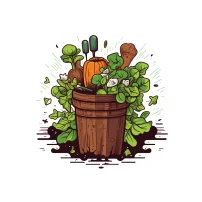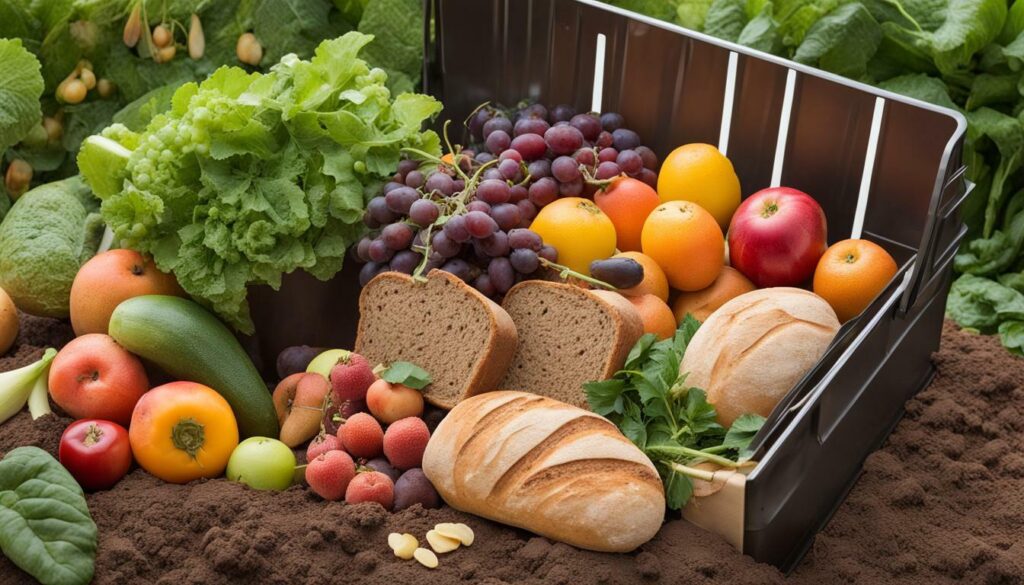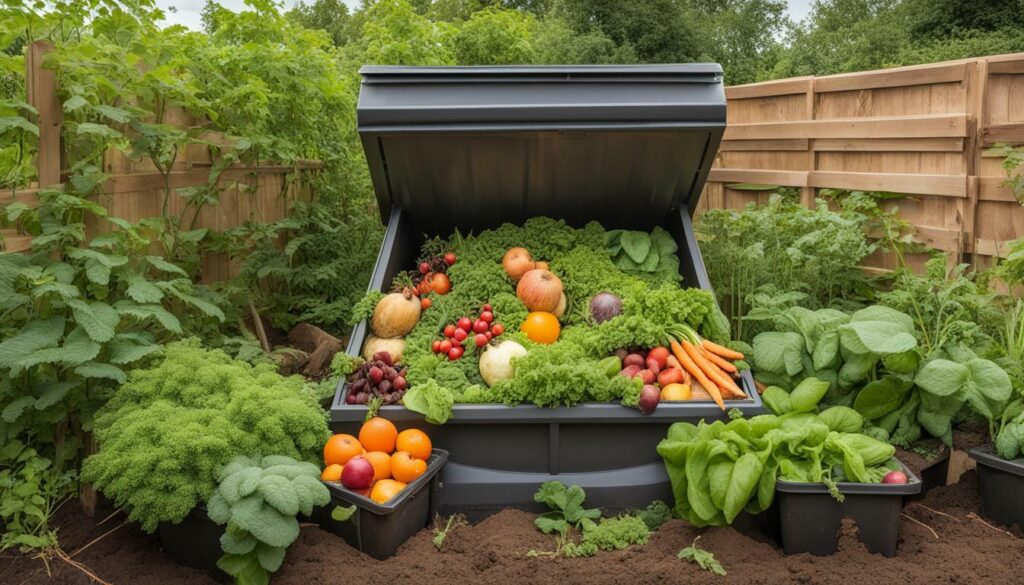Composting is an eco-friendly practice that can help reduce food waste and create nutrient-rich soil for gardening. However, not all types of food waste can be composted equally. One common question people have is, “Can you put bread in a compost bin?”
The short answer is yes, but there are some important considerations to keep in mind. In this article, we will provide a comprehensive guide to composting bread, including tips, guidelines, and common mistakes to avoid.
Key Takeaways:
- Bread can be composted, but it needs to be broken into small pieces or turned into breadcrumbs to speed up the composting process.
- Layer bread with other compostable materials and maintain the right balance of carbon and nitrogen for optimal results.
- Avoid common mistakes such as adding too much bread at once, not properly aerating the compost bin, or failing to maintain the right moisture levels.
- Alternative uses for bread scraps include making croutons, bread pudding, or feeding them to birds.
- Composting bread can be done in different composting systems, but adjustments may be needed for each system.
- Finished compost that contains bread residues can be used in gardening and plant care to enrich soil and promote healthy plant growth.
- Composting bread is a sustainable practice that can contribute to a healthier environment and reduce food waste.
Understanding Composting Basics
Composting is a natural process of turning organic materials into a nutrient-rich substance that can enrich soil and support plant growth. Composting involves breaking down materials such as food scraps, yard waste, and leaves, using bacteria, fungi, and other microorganisms.
When it comes to composting bread, the process is no different. Bread can be a valuable addition to a compost bin, but it’s important to understand the basics of composting to ensure that the bread waste breaks down properly.
| What can be composted? | What cannot be composted? |
|---|---|
| Bread scraps, fruits and vegetables, coffee grounds, tea bags, eggshells, yard waste, leaves, and grass clippings. | Meat, dairy products, bones, oils, grease, pet waste, and plastics. |
It’s important to maintain the right balance of carbon and nitrogen in a compost bin to ensure that the materials break down properly. Carbon-rich materials, such as leaves and yard waste, help create a healthy environment for microorganisms. Nitrogen-rich materials, such as food scraps and grass clippings, provide the nutrients that microorganisms need to thrive.
When composting bread, it’s a good idea to break it into small pieces or turn it into breadcrumbs. This helps speed up the composting process by exposing more surface area to the microorganisms. Layering bread with other compostable materials can also help maintain the right balance of carbon and nitrogen.
By following these basic rules of composting, bread waste can be turned into a valuable resource for gardening and plant care.
Guidelines for Composting Bread
Composting bread effectively requires some attention to detail in the preparation and handling of the bread scraps. To ensure optimal results, follow these guidelines:
- Cut or tear bread into small pieces: Breaking up the bread into small pieces or turning it into breadcrumbs can help speed up the composting process.
- Layer the bread: Place the bread scraps in the compost bin in layers with other organic materials, such as fruit and vegetable scraps.
- Maintain the right balance of carbon and nitrogen: If the compost becomes too moist, add more carbon-rich materials, such as dry leaves or shredded paper. If it appears too dry, add more nitrogen-rich materials, such as grass clippings or fruit peels.
- Aerate the compost: Turning the compost frequently can help ensure the bread scraps break down properly. Use a pitchfork or garden tool to mix the materials in the bin.
- Watch for signs of trouble: If you notice any foul odors or signs of pests, adjust the compost mix and try to eliminate the problem.
- Be patient: Composting bread takes time, typically six months to a year, depending on the size of the bread scraps and the composting conditions. Be patient and consistent in your efforts.
By following these guidelines, you can compost bread successfully and create a rich, healthy soil amendment for your garden or houseplants.
Common Mistakes to Avoid When Composting Bread Waste
Composting bread can be a great way to reduce food waste and create rich compost for your garden. However, there are some common mistakes that can prevent successful bread composting. Here are some of the most important mistakes to avoid:
Adding Too Much Bread at Once
One of the biggest mistakes people make when composting bread is adding too much at once. Bread can be a high-nitrogen material, and too much nitrogen can disrupt the carbon-to-nitrogen balance in your compost pile or bin. It’s best to add bread in small amounts, mixing it in with other compostable materials such as leaves or grass clippings.
Not Properly Aerating the Compost Bin
Another common mistake is not properly aerating the compost bin when composting bread waste. Bread can create a dense, heavy mass that can become anaerobic and produce a foul odor. To avoid this, make sure to turn your compost pile or use a compost bin with adequate ventilation to provide enough oxygen to the microorganisms that break down the bread.
Failing to Maintain the Right Moisture Levels
Bread contains a lot of moisture, so it’s important to monitor the moisture level in your compost bin when composting bread. If the compost becomes too wet, it can become waterlogged and anaerobic, leading to a foul odor and slow decomposition. If the compost is too dry, it can become too aerated and slow down the decomposition process. It’s important to keep the moisture level at about 50-60% for optimal composting.
By avoiding these common mistakes, you can ensure successful and effective composting of bread waste. Remember to always monitor the carbon-to-nitrogen ratio, properly aerate the compost bin, and maintain the right moisture levels for healthy composting.
Alternative Uses for Bread Scraps
Composting bread scraps is not the only way to use them. There are several alternative uses that can reduce food waste and add variety to your diet.
Make Croutons: Toast bread cubes in an oven with some olive oil, salt, and herbs. They can be added to salads or used as a snack.
Bread Pudding: Mix bread cubes with eggs, milk, sugar, and cinnamon. Bake in the oven for a delicious dessert.
Feed Birds: Instead of throwing bread scraps away, consider feeding them to birds. Make sure to break them into small pieces first.
These are just a few ideas for utilizing bread scraps. Get creative and experiment with different recipes.
Composting Bread in Different Composting Systems
Bread can be composted effectively in various composting systems, depending on the type of system and the composting process used. In this section, we will explore how to compost bread in different composting systems and provide tips on adjusting the process accordingly.
Traditional Compost Bins
Traditional composting involves using a bin or pile to break down organic matter through a natural biological process. When composting bread in a traditional compost bin, it’s essential to break the bread into small pieces to speed up the composting process. Breadcrumbing the bread is also an excellent option for faster decomposition. To ensure the right balance of carbon and nitrogen, mix the bread with other compostable materials such as yard waste, fruit and vegetable scraps, and eggshells. Layer the materials, keeping the compost moist but not too wet, and aerate it occasionally by turning it with a compost fork or pitchfork. Doing so will help the bread break down faster and reduce the risk of attracting pests.
Worm Composting Bins
Worm composting, also known as vermicomposting, uses red wiggler worms to break down organic matter. When composting bread in a worm bin, break the bread into small pieces or turn it into breadcrumbs and add it to the bin with other food scraps. Worm compost bins require more attention to moisture levels than traditional compost bins. Too much moisture can cause the bread to become moldy or sour and attract pests. To avoid this, balance the moisture level by adding dry bedding such as shredded paper, leaves, or coconut coir to the bin. Keep the bedding moist, but not too wet, and ensure proper ventilation by drilling small holes in the bin’s lid.
Compost Tumblers
Compost tumblers are rotating drums that speed up the composting process by providing aeration and constant mixing. When composting bread in a tumbler, break the bread into small pieces and add it to the drum with other compostable materials. Turn the drum regularly to ensure even decomposition, and monitor the moisture level to prevent the bread from becoming soggy. Compost tumblers are generally more expensive than traditional compost bins, but they offer faster results and more efficient use of space.
Troubleshooting Common Issues
Composting bread waste can sometimes lead to issues that can be easily resolved with a few adjustments to the composting process. Here are some common problems you may encounter when composting bread and what you can do to fix them.
Attracting Pests
If your compost bin is attracting pests such as rodents or flies, it may be due to adding too much bread at once or not burying it deep enough within the compost pile. To prevent pests, avoid adding too much bread at once, and bury it under a layer of other compostable material. You can also store bread scraps in the freezer until you’re ready to compost them to discourage pests.
Foul Odors
Composting bread waste may produce a foul odor if the compost pile is too wet or contains too much bread. To avoid foul odors, add bread in small quantities and layer it with dry and brown materials, such as leaves or sawdust, that will help balance the moisture levels and absorb any excess odors.
Slow Composting
Composting bread waste may take longer to break down than other materials because of its high water content. To speed up the composting process, break down bread into small pieces or turn it into breadcrumbs before adding it to the compost bin. You can also mix in other high-nitrogen materials, like coffee grounds or grass clippings, that will help the compost break down faster.
With these bread composting tips, you will be able to troubleshoot and resolve any problems that may arise, ensuring a successful and efficient composting process.
Using Finished Compost with Bread Residue
Once the composting process is complete, the finished compost can be used in gardening and plant care. Compost that contains bread residues can be particularly beneficial due to the added nutrients. The organic matter in the compost can help to enrich soil and promote healthy plant growth.
To use the finished compost with bread residue, it is important to apply it correctly. Spread the compost over the soil in a layer that is 2-3 inches deep. Work the compost into the top layer of soil with a rake or shovel. This will help to incorporate the nutrients into the soil and improve its overall quality.
When applying compost with bread residues, it is important to do so in moderation. While the nutrients can be beneficial, too much compost can actually harm plants by causing them to grow too quickly. Use compost with bread residue in combination with other fertilizers and follow the recommended guidelines for the specific plants.
Overall, using finished compost with bread residue can be a great way to reduce waste while also improving the health of your garden or plants. So, consider composting bread waste as part of your sustainable gardening practices.
Composting Bread in a Community or Municipal Composting System
When composting bread waste in a community or municipal composting system, it is important to adhere to specific guidelines and regulations. Many municipalities have strict rules on what can and cannot be composted, so it is essential to check with local authorities before adding bread to a public compost bin.
If bread is allowed in the community composting system, there may be additional instructions to follow. For instance, some systems require bread to be broken down into smaller pieces or mixed with other compostable materials to facilitate the composting process.
It is crucial to avoid contaminating the compost with non-compostable materials, such as plastic or metals. Make sure to remove any packaging or wrapping from the bread before adding it to the compost bin. Additionally, avoid adding bread that has been heavily processed or contains preservatives, as these ingredients may harm the compost’s beneficial microbes.
Avoid adding too much bread at once, as this can overwhelm the compost bin and lead to slow decomposition or foul odors. Instead, add bread scraps gradually, mixing them with other organic waste to maintain the proper carbon-to-nitrogen ratio.
By following a bread composting guide and complying with local regulations, individuals can contribute to a more sustainable and eco-friendly community.
Composting Bread for a Sustainable Future
Composting bread can contribute significantly to a sustainable future. By reducing food waste and utilizing compost, individuals can play an active role in protecting the environment.
Composting bread waste provides an excellent opportunity to enrich the soil with valuable nutrients, reducing the need for chemical fertilizers. Moreover, composting helps to reduce greenhouse gas emissions that result from food waste in landfills.
Implementing some bread composting tips, such as using worm bins or breaking the bread into small pieces, can minimize food waste while producing compost for healthier plants, vegetables, and fruits. By composting bread, individuals can lead a sustainable lifestyle and reduce their carbon footprint.
So, to make a significant impact on the environment and create a more sustainable future, consider composting bread waste instead of sending it to landfills. Follow these composting bread tips for a greener and healthier planet.
Conclusion
In conclusion, the answer to the question “Can you put bread in a compost bin?” is a resounding yes. Composting bread is a sustainable practice that can contribute to a healthier environment by reducing food waste and utilizing compost to enrich soil and promote healthy plant growth.
By understanding the basics of composting, following proper guidelines, avoiding common mistakes, and troubleshooting issues that may arise, anyone can successfully compost bread in their backyard or community composting system.
Bread scraps can also be repurposed for alternative uses such as making croutons, bread pudding, or feeding birds, providing additional ways to reduce food waste.
Incorporating bread composting as part of a green lifestyle can have far-reaching benefits for the environment and the community. So, don’t hesitate to start composting your bread scraps today and making a positive impact on the planet.



